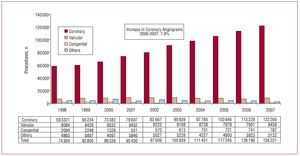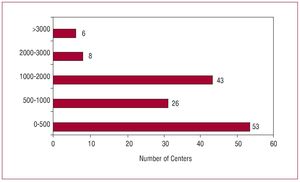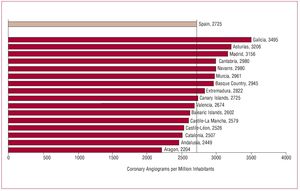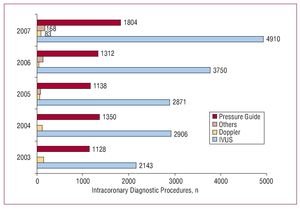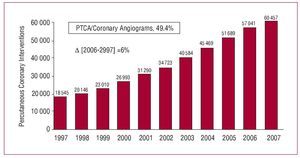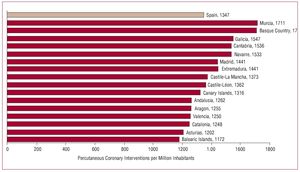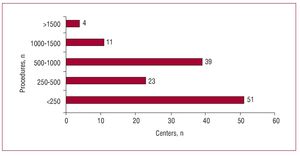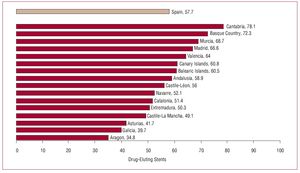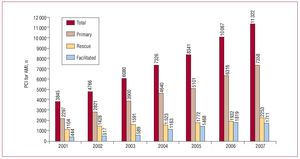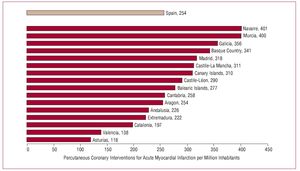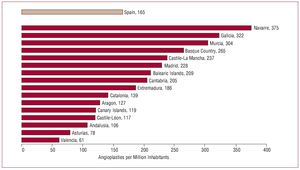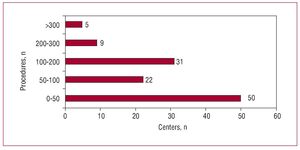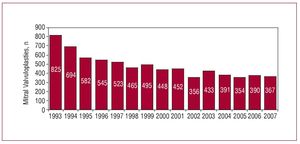Keywords
INTRODUCTION
Interventional cardiology is at a decisive moment, with the appearance of new therapies such as percutaneous aortic valve implants and the development of new approaches to manage known situations, as is the case with the different techniques in chronic occlusions, bifurcations, or percutaneous treatment of disease of the left main coronary artery. Furthermore, we are still investigating when is the best time for intervention in acute coronary syndrome with or without ST elevation. In Spain, we are using these approaches and with the Working Group on Cardiac Catheterization and Interventional Cardiology as a platform, we are trying to compile as much information as possible on this type of activity to provide the scientific community with the necessary information. Since 1990, the primary aim of the Working Group has been to collect and analyze the data from Spanish hospitals that practice catheterization procedures with data collection methods that are improving each year.1-16 The collection and analysis of this information is a clear reflection of the fact that the scientific community associated with interventional cardiology wishes to better itself. Data corresponding to procedures in 2007 were presented to members of the Working Party in their annual meeting, which took place on June 19-21, 2008 in Sancti-Petri, Cadiz, Spain (available from: http://www.hemodinamica.com).
The level of information obtained provides, on the one hand, knowledge of the actual situation in Spain and how it relates to international experience and, on the other, allows assessment of the development of interventional cardiology in the different autonomous regions of Spain. Open access to these data favors knowledge of the distribution of resources and evaluation of the different trends in usage and the frequency of diagnostic and therapeutic procedures.
This article is the 17th report of catheterization procedures in Spain and covers the activity of all public and most private hospitals.
METHODS
Data collection was done using a common questionnaire (Appendix 1), which was distributed to all catheterization laboratories in Spain by 2 routes. The first route was by means of the website of the Spanish Society of Cardiology Working Group on Cardiac Catheterization and Interventional Cardiology (http://www.hemodinamica.com) with an online form. In the other route, data were obtained by the "traditional" method using the same form in hardcopy; the company Izasa was responsible for distributing and collecting them. The analysis of the information obtained was done by the management board of the working group and is made public in this article.
The population calculations, both for the country as a whole and for each autonomous region, were done based on the population estimations of the Spanish National Institute of Statistics for January 31, 2007, and published on their website (http://www.ine.es). Spain was estimated to have a population of 44 873 567 inhabitants.
As in previous registries, public hospitals were taken to be those which, regardless of where they obtained funding from, consistently attended a certain section of the population within the public health system. The remaining hospitals were considered as private.
RESULTS
Infrastructure and Resources
One hundred and twenty-nine hospitals (Appendix 2) carrying out catheterization procedures participated in the registry. Of these, 14 centers also admitted pediatric patients. Of the all the hospitals that submitted data, 74 are public (100% of all such hospitals with catheterization facilities) and 55 are private. These hospitals account for 99% of the hospitals that perform catheterization in Spain; 173 catheterization laboratories are available, of which 116 (67%) are located in public hospitals. The number of hospitals and laboratories worked out at 2.8 and 3.82, respectively, per million inhabitants, with no changes with respect to 2006. An emergency team is available 24 hours a day in 63% of the centers. Heart surgery is available in 69% of the centers (66% of the public hospitals and 80% of the private ones).
With regard to hospital staff, 125 centers reported the presence of 409 doctors who performed catheterization procedures during 2007 (3.27/center; 9.1 specialists/ 1 000 000 inhabitants). The public hospitals had 3.9 physicians per center and 2.5 per laboratory. In the private sector, those figures were 2 per hospital and 2 per laboratory. As for staff other than qualified doctors, of the 124 hospitals that reported data, 492 qualified nurses (DUE) and 100 radiodiagnostic technicians (ATR) were present, corresponding to an average of 4.8 nurses and/or radiodiagnostic technicians per hospital and 3.4 per laboratory.
Diagnostic Activity
During 2007, 136 231 diagnostic procedures were undertaken in Spain, a figure that represents an increase of 7.9% with respect to 2006. Of these procedures, 122260 were coronary angiograms. Twenty-seven percent were done in women and 24% in patients aged over 75 years, corresponding to an increase of 5.3% and 4.9% with respect to the previous year. With these data, a national average of coronary angiograms of 2725 procedures/ 1 000 000 population can be calculated. The most recent data published by the European registry refer to 2005 and put the figure at 4030 angiograms/1 000 000 population among the countries that participated in the registry.17
Figure 1 shows the distribution of all diagnostic procedures. The progressive increase in the number of coronary angiograms can be seen over the last 10 years; the number of studies done in patients with congenital heart diseases remains constant and catheterization studies of heart valves increased by 20% after the decrease observed in preceding years.
Figure 1. Change in the number and type of diagnostic procedures done between 1998 and 2007.
During 2007, public hospitals were responsible for 89% of diagnostic activity; 51 centers performed more than 1000 coronary angiograms and 14 more than 2000, which represents 41% and 11%, respectively, of the total centers with data available (Figure 2). A mean of 1056 diagnostic procedures were performed per center and 787 per laboratory—this does not represent any substantial changes with respect to the 2 previous registries.14-16 With regard to public centers, 1626 (925) diagnostic procedures per hospital were done.
Figure 2. Distribution of hospitals according to the number of coronary angiograms performed.
The national average for coronary angiograms was 2725 (330) procedures/1 000 000 population. Figure 3 shows the data by Spanish autonomous region. A greater tendency towards a more even distribution among autonomous regions can be discerned, with a range of 757 procedures if we exclude the 2 most outlying values.
Figure 3. Distribution of coronary angiograms per million inhabitants by autonomous region.
With regard to the intracoronary diagnostic techniques, intravascular ultrasound is the most widely used technique, followed by pressure wires. Of note is the increase in the use of both compared to the previous year. This increase is 31% (4910 procedures) in the case of ultrasound and 37% in the case of pressure wires (1804 procedures in total). The use of intracoronary Doppler ultrasound changed the trend of previous years, and its use increased from 35 procedures in 2006 to 83 in 2007. Of the other diagnostic techniques, of note is optical coherence tomography, with 142 procedures last year; other procedures with a small number of cases are endothelial function studies, thermography, and intracardiac ultrasound. Figure 4 shows the changes in the usage of the different intracoronary diagnostic techniques in recent years.
Figure 4. Change in the different intracoronary diagnostic techniques.
The femoral artery is still the preferred approach route for Spanish catheterization specialists, but the increase in the use of the radial artery seen in previous years continued and in 2007, 41.4% of the diagnostic procedures used this approach compared to 38.1% the preceding year.
Percutaneous Coronary Intervention
During 2007, 60 457 percutaneous coronary interventions (PCI) were performed, an increase of 6% with respect to the previous year. This increase was less than the 7.8% increase in 2006 and the 13.1% increase in 2005. The changes over time in PCI in Spain in the last 10 years are presented in Figure 5. The number of PCI/million inhabitants was 1347 (171) in all of Spain, that is, less than the latest European figures of 1601
Figure 5. Change in the number of percutaneous coronary interventions between 1996 and 2007. PTCA indicates per percutaneous coronary angioplasty.
PCI/million inhabitants in 2005.17 The mean number of PCI procedures undertaken was 487 per center and 349 per laboratory. The mean annual number of PCI procedures per operator was 150. Public sector hospitals performed 90% of coronary interventions, and the mean number of PCI per hospital was 735 procedures (469 procedures per laboratory). With regard to the number of procedures per operator, these decreased 9.5% compared to 2006, when that number was 189.
The rate of PCI/coronary angiography in 2007 was 49.4%, that is, 1% less than in 2006, which reflects the larger increase in the number of coronary angiograms than the number of PCI. The number of procedures for multivessel disease remained unchanged compared to the previous year and accounted for 28% of all PCI. The number of PCI performed at the same time as the diagnostic procedure— 49 669 (82%) in 2007—continued to increase.
In 24.7% of the procedures, the patients were women and in 26.3%, they were over 75 years of age. In 5.5% of the cases, the PCI procedures were done on 1 or more restenotic lesions (5.3% in 2006). Table 1 shows how the percentage of PCI on restenotic lesions has broken the downward trend of previous years, something that could be explained in part by a decrease in use of drug-eluting stents (DES). The number of procedures involving the left main coronary artery continued to increase in Spanish hospitals; in 2007, 2231 procedures were performed, and the artery was unprotected in 76% of these (n=1690), corresponding to 3.7% of all PCI procedures. Graft treatments accounted for 2.4% of the total; the saphenous vein being the most used (1173 procedures, 81% of all such procedures) followed by the mammary artery (274 procedures).
Glycoprotein IIb/III inhibitors were used as coadjuvant pharmacological treatment in 15184 procedures (25.1%), abciximab being the most frequently used of this class (64.9%) although 5.3% less than in 2006. Tirofiban was used in 22% of the PCI procedures and of note is the increase in use of eptifibatide from 3.7% to 9.1%. This year, information was requested on direct thrombin inhibitors, specifically bivalirudin, which was used in 3.1% of the procedures. This increase refers to the total number of procedures in which glycoprotein IIb/IIIa inhibitors were used. The timing of drug administration is not specified as this variable was not included in the data collection form for the registry. Counterpulsation intraaortic balloons were used 1267 times (a 22% increase compared to 2006), and use of other cardiac support methods was merely anecdotal, with only 24 cases being reported.
The distribution by autonomous region of the 1347 PCI/million inhabitants in Spain is shown in Figure 6. This distribution is a little more homogeneous than the ones in previous registries. The range is greater than in 2006 (539 compared to 600 procedures), although the number of regions above the national average was greater in 2007 than 2006 (9 vs 8, respectively). Examination of the distribution by centers (Figure 7) shows that the number of hospitals performing fewer than 500 PCI per year remained stable whereas the number of those that performed a high volume of procedures increased notably, with 15 hospitals performed more than to above 1000 angioplasties in the year.
Figure 6. Distribution of percutaneous coronary interventions per million inhabitants by autonomous region.
Figure 7. Distribution of centers according to the number of percutaneous coronary interventions done in 2007.
The percentage of successful outcomes from PCI procedures remained similar to previous years. Overall, 94% were successful, 4.6% were failures without complications, and 1.5% were failures with complications. The complications were as follows: 0.4% mortality, 0.7% acute myocardial infarction (AMI), and 0.1% emergency surgery. In-hospital mortality was 0.9%.
The intracoronary diagnostic techniques (intravascular ultrasound [IVUS] and pressure guidewires) used essentially for guiding decisions to treat lesions of doubtful severity, improve the outcome of the intervention and, to a lesser extent, as part of investigational protocols, increased in 2007, and the rate of use of IVUS per PCI was 8.1% and pressure guidewire 3%.
Radial artery approach increased substantially to the extent that such procedures for diagnosis accounted for as many as 40.1% of the interventional procedures compared to 29% in 2006. Femoral access was used with 40 229 percutaneous closure devices, of which 59.5% were with collagen, 19.7% with suture, and 20.8% other types of device.
Stents
In total, during 2007, 94 916 stents were implanted during 55 722 procedures, yielding a ratio of stents/procedure of 1.7, slightly higher than the previous year (1.6). Of all the units implanted, 57.7% were DES, that is, a decrease of 1.6% compared to the previous year with respect to bare-metal stents, as the total increase in implanted stents was 4.3% whereas the increase for DES was only 1.5%. This is the first time that the proportion decreased with respect to bare-metal stents since they have been available in Spain.
Use of DES shows large differences between the different autonomous regions—between 78% and 34.8%—as shown in Figure 8. These differences are slightly greater than in 2006 (range of 37.5% in 2007 compared to 36% in 2006).
Figure 8. Distribution of the percentage of drug-eluting stents compared to the total number of stenting procedures by autonomous region.
As for stent safety, this year, 494 cases of stent thrombosis have been recorded (data from 61 centers). Compared to the previous year, it is worthwhile noting that the percentage of each type of stent has changed. Thus, the rate of thrombosis in bare-metal stents increased from 37% to 46% of the total, with the usual decrease in the case of DES. There are also changes in when thrombosis occurs, so while there are almost no differences in early thrombosis compared to 2006, there is a trend towards similar rates in late and very late thrombosis, probably because of the changes in the treatment regimens of double antiplatelet therapy and because of optimization of implantation after the controversy surrounding DES thrombosis. Data for both years are shown in Table 2.
Other Devices Used in Percutaneous Coronary Intervention
Rotational abrasion (rotablator) atherectomy procedures increased both in terms of the number of hospitals and in the total number of procedures: 57 hospitals (increase of 10%) and 770 procedures (increase of 20%). There were no reports of directional atherectomy or intracoronary brachytherapy. The use of other devices has also increased in 2007. Thus, cutting balloon usage increased by 14%, distal protection by 17%, and thrombus extractors by 53%.
Interventions During AMI
A total of 117 centers provided data on interventions during AMI. A total of 11 322 PCI procedures for AMI were carried out, representing an increase of 12.5% compared to 2006. In the European registry in 2005, PCI for AMI accounted for 17% of all PCI procedures, whereas in Spain, this procedure accounted for 18.7% in 2007.17
Of the total number of procedures, 1913 (17%) were performed in women. In patients aged over 75 years, 2235 procedures were carried out (20%). Glycoprotein IIb/IIIa inhibitors were used in 58.8% of angioplasties for ST elevation AMI (STEMI) and thrombus extraction in 29% of the procedures.
Within the range of PCI procedures done during the acute phase of AMI, the distribution is similar to previous years: 7359 (65%) primary PCI, 2253 (19.9%) rescue PCI, and 15.1% of the PCI were facilitated (Figure 9). The growing number of interventional procedures in AMI is due to increased primary and facilitated PCI (24% in both cases), with a small increase in rescue PCI (9%). For an annual estimate of 45 000 admissions to Spanish hospitals for AMI,18,19 primary PCI would be applied in only 16.3% of the cases of AMI. Forty-eight hospitals reported the time from door to balloon procedure. The mean time was 84.1 (42) minutes.
Figure 9. Distribution of percutaneous coronary interventions (PCI) during acute myocardial infarction (AMI).
The national distribution of PCI in AMI showed large variations, with a mean of 254 PCI procedures/million inhabitants and a range of 283 procedures. This range is much more marked in the case of primary PCI with a difference of 314 procedures (Figures 10 and 11).
Figure 10. Distribution of percutaneous coronary interventions for acute myocardial infarction per million inhabitants by autonomous region.
Figure 11. Distribution of primary angioplasty per million inhabitants and autonomous region.
The mean PCI per hospital is similar to that of the previous year, with 97 procedures (100 in 2006) and the spread among hospitals is maintained, as 61% undertook fewer than 100 PCI for AMI/year as shown in Figure 12.
Figure 12. Distribution of hospitals according to the number of percutaneous coronary interventions during acute myocardial infarction.
As in other procedures, radial approach was also used in PCI during AMI, in a total of 3657 procedures (32.3% of the total), corresponding to an increase of 6.5% with respect to the previous year.
There were 1012 PCI procedures in patients who were in cardiogenic shock in the acute phase of AMI. The procedure was successful in 51% of the cases and major complications were reported in 45%, with an in-hospital mortality of 30%.
Noncoronary Interventions in Adults
Valvuloplasties leveled off in terms of the number of procedures; in total there were 441 during 2007, a similar figure to 2006. There were 367 procedures (83%) performed on the mitral valve, 37 on the aortic valve, and as many again on the pulmonary valve (Figure 13). Mitral valvuloplasty was successful 90.7% of the time, with complications reported in 5.7% of the procedures. The most common complication was severe mitral valve regurgitation after valvuloplasty (2.4%), followed by tamponade (2.1%), and death and stroke (0.6% between the two). Eighteen percutaneous valve implantations were reported, 6 in the pulmonary valve, all successful, 12 in the aortic valve. Of these 3 were with self-expanding and 6 non-self-expanding devices.
Figure 13. Change in number of mitral valvuloplasties in Spain.
Treatment of congenital heart disease in adults is the most common noncoronary interventional procedure in the current registry. A total of 622 procedures were performed, and the most frequent was closure of atrial septal defect (ASD), with 334 cases in total, of which 95.5% were performed with success. Complications were reported in 0.8%, and these consisted of device embolization. No mortality was associated with the procedure, as was the case in 2006. A total of 196 patent foramen ovales were closed, with success in 89% of the procedures. Aortic coarctations were treated in 34 patients. The remaining 41 procedures were closure of ductus, ventricular septal defects, and fistulas.
Forty-six paravalvular leaks were treated, 35 of which were mitral and 11 aortic. Seventy-nine procedures were done with implantation of aortic endoprosthesis, 40 of which were placed in the abdominal aorta, and 39 in the thoracic aorta.
In 57 cases, stem cells were implanted, and 37 septal ablations were performed in patients with obstructive hypertrophic cardiomyopathy.
Interventional Procedures in Pediatric Patients
A total of 14 centers provided data on catheterization procedures in pediatric patients (up to age 16 years), reporting 318 procedures in 2007. The most common procedures were dilatations, both vascular and valvular, accounting for a total of 127 procedures. Closure of ASD and persistent ductus arteriosus accounted for 36% of the total, with 64 cases each. Pediatric procedures are presented in detail in Figure 14.
Figure 14. Distribution of pediatric interventions performed in adult hospitals without specific pediatric activity. ASP indicates atrial septal defect.
CONCLUSIONS
In 2007, the activity of the Spanish hospitals that undertake PCI procedures followed the upward trends in the number of procedures that had been seen in previous years.
Diagnostic procedures increased due to increases in the number of coronary angiograms and the national distribution showed less variability than in previous years among different autonomous regions, probably due to better distribution of resources, with new laboratories being opened in a greater number of provinces. The total number of diagnostic procedures in patients with congenital heart disease and valve disease showed no increase. The most used intracoronary diagnostic techniques were intravascular ultrasound, which increased 30% with respect to the previous year.
The differences in coronary procedures among different regions of Spain were in general maintained.
It is likely that the clinical practice guidelines for management of AMI have led to an increase in the number of interventional procedures through an increase in the number of primary PCI procedures. Nevertheless, there are marked differences between autonomous regions in favor of those with a specific patient protocol for ST-elevation AMI.
DES have decreased their share with respect to 2006, and the national average is 57.7%, with a wide variability between the different autonomous regions and a similar distribution to that of previous years. The use of rotational atherectomy has increased considerably both in terms of the number of hospitals and the number of procedures, probably as a result of the greater complexity of the lesions currently treated.
Radial approach accounted for more than 40% of approach routes for both diagnostic and interventional procedures and is increasingly used in AMI.
With regard to interventional procedures, the number of valvuloplasties and procedures to treat congenital heart disease in adults have leveled off compared to the last 2 years, thus ending the gradual decline in the number of such procedures performed, and percutaneous valve placement has begun with 18 procedures.
Due to the lack of current data from other countries, we cannot make comparisons.
ACKNOWLEDGEMENTS
The Spanish Society of Cardiology Working Group on Cardiac Catheterization and Interventional Cardiology would like to th ank the heads of the catheterization laboratories throughout Spain and those responsible for data collection for their efforts to make this registry possible.
ABBREVIATIONS
AMI: acute myocardial infarction
DES: drug-eluting stent
LMCA: left main coronary artery
PCI: percutaneous coronary intervention
Correspondence: Dr. J.A. Baz Alonso.
Cardiología Intervencionista. Complejo Hospitalario Universitario de Vigo. Meixoeiro, s/n. 36200 Vigo. Pontevedra. España.
E-mail: jose.baz.alonso@sergas.es; joseantoniobaz@gmail.com
